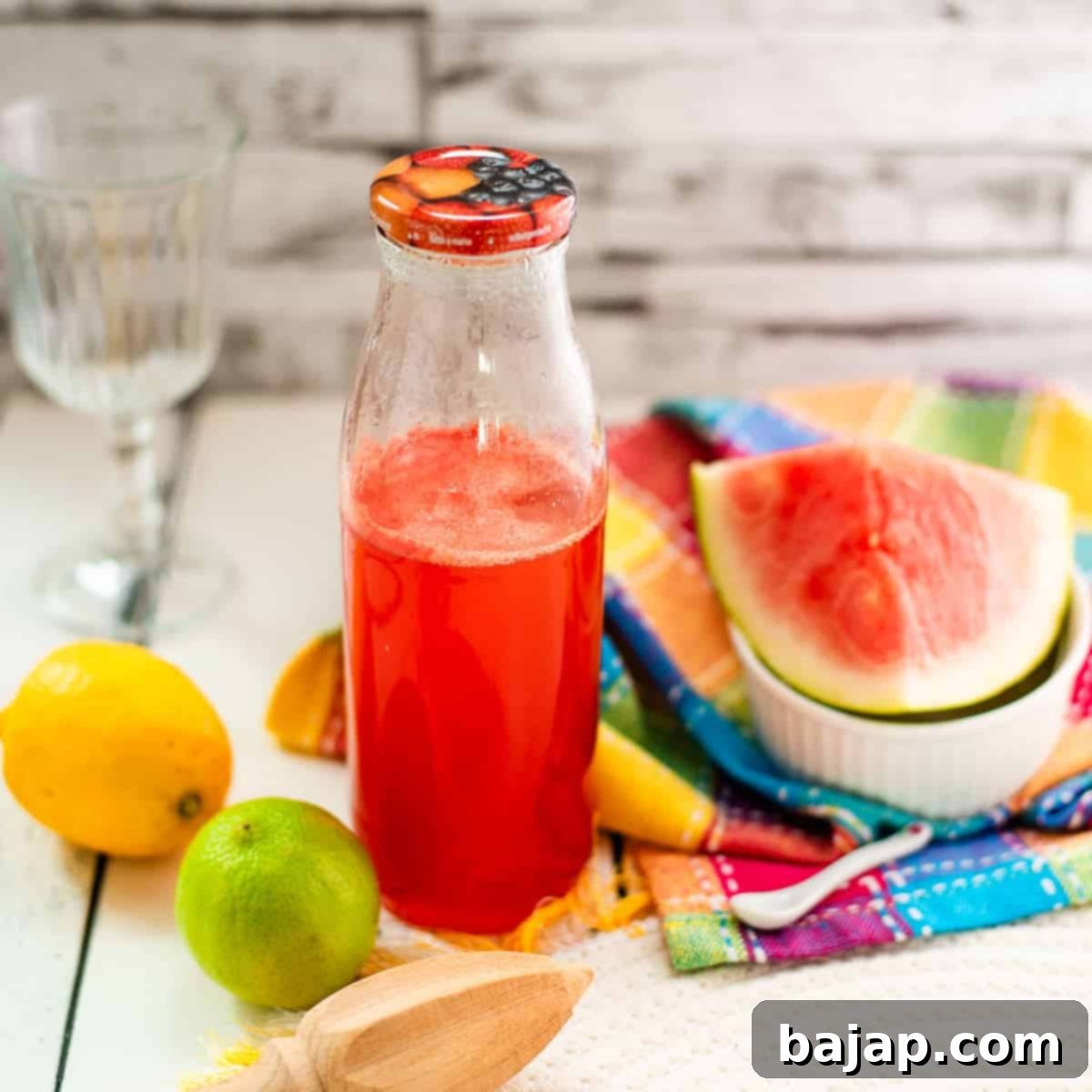Homemade Watermelon Syrup: Your Ultimate Guide to Sweetening Summer Drinks & Desserts
Welcome to the peak of watermelon season! There’s nothing quite like biting into a slice of perfectly ripe, juicy watermelon on a hot summer day. This quintessential summer fruit is at its absolute best in June, July, and August, bursting with natural sweetness and a refreshing flavor. While enjoying it fresh is always a treat, why not capture that incredible taste to savor all year long? With this easy-to-follow guide, you’ll learn how to make the most of this bountiful season by transforming your favorite fruit into a delightful homemade watermelon syrup!
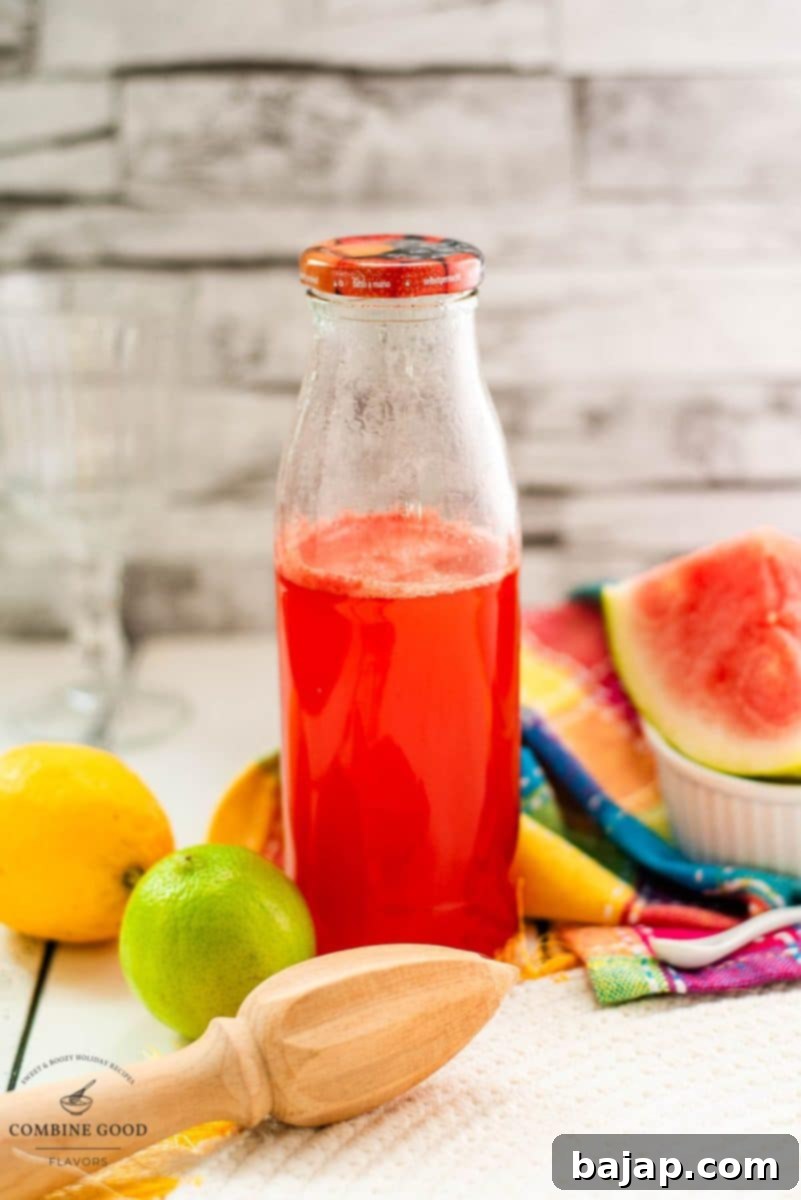
Watermelon syrup is far more than just a fancy addition to cocktails or refreshing beverages. It’s a surprisingly versatile ingredient that can add a unique, bright, and natural sweetness to an array of culinary creations. Imagine drizzling this vibrant, ruby-red syrup over creamy scoops of homemade vanilla ice cream, incorporating it into desserts for an unexpected twist, or even using it to glaze savory dishes for a touch of sweet-fruity elegance. Its potential in the kitchen is truly endless, making it a must-have for any home cook looking to enhance their summer repertoire.
Why Make Your Own Watermelon Syrup?
Beyond the sheer enjoyment of a homemade product, there are several compelling reasons to make your own watermelon syrup:
- Unbeatable Freshness & Flavor: Store-bought syrups often rely on artificial flavors and excessive sugars. Crafting it yourself ensures you get the pure, unadulterated taste of fresh watermelon, brightened by real citrus. You control the intensity of the watermelon flavor, ensuring it’s exactly to your liking.
- Control Over Ingredients: You dictate what goes into your syrup. There’s no need for high-fructose corn syrup, artificial colors, or preservatives you can’t pronounce. Just natural goodness from wholesome ingredients.
- Cost-Effective: During peak season, watermelons are abundant and often inexpensive. Turning them into syrup is an economical and smart way to capture and enjoy their fleeting seasonal flavor for months to come.
- Customizable Sweetness & Tartness: The beauty of homemade is customization. Adjust the amount of sugar and citrus juice to perfectly match your preferences. Prefer it sweeter? Add a touch more sugar. Want a tangier kick? Increase the lemon or lime for a more vibrant profile.
- Perfect Food Gift: Bottled homemade watermelon syrup makes for a thoughtful, unique, and highly appreciated gift for friends and family, especially during the summer holidays or as a host gift.
And the best part of this delicious endeavor? It’s incredibly easy to make! I’m thrilled to guide you through two simple, straightforward methods for creating your very own watermelon-infused syrup. Whether you prefer a quick boil for a more shelf-stable option or a no-cook approach for maximum fresh flavor, we’ll cover both so you can choose the technique that best fits your kitchen and schedule.
So, let’s jump right in and harness the incredible flavor of this watermelon season together! It’s going to be a delicious and rewarding adventure that will infuse your summer (and beyond!) with a taste of pure sunshine and endless possibilities.
🥘 Ingredients for Watermelon Syrup
Creating this delightful watermelon syrup requires just a few simple ingredients, easily found at your local grocery store. The foundational secret to an exceptional syrup lies in starting with a high-quality, ripe watermelon to ensure the best flavor base.
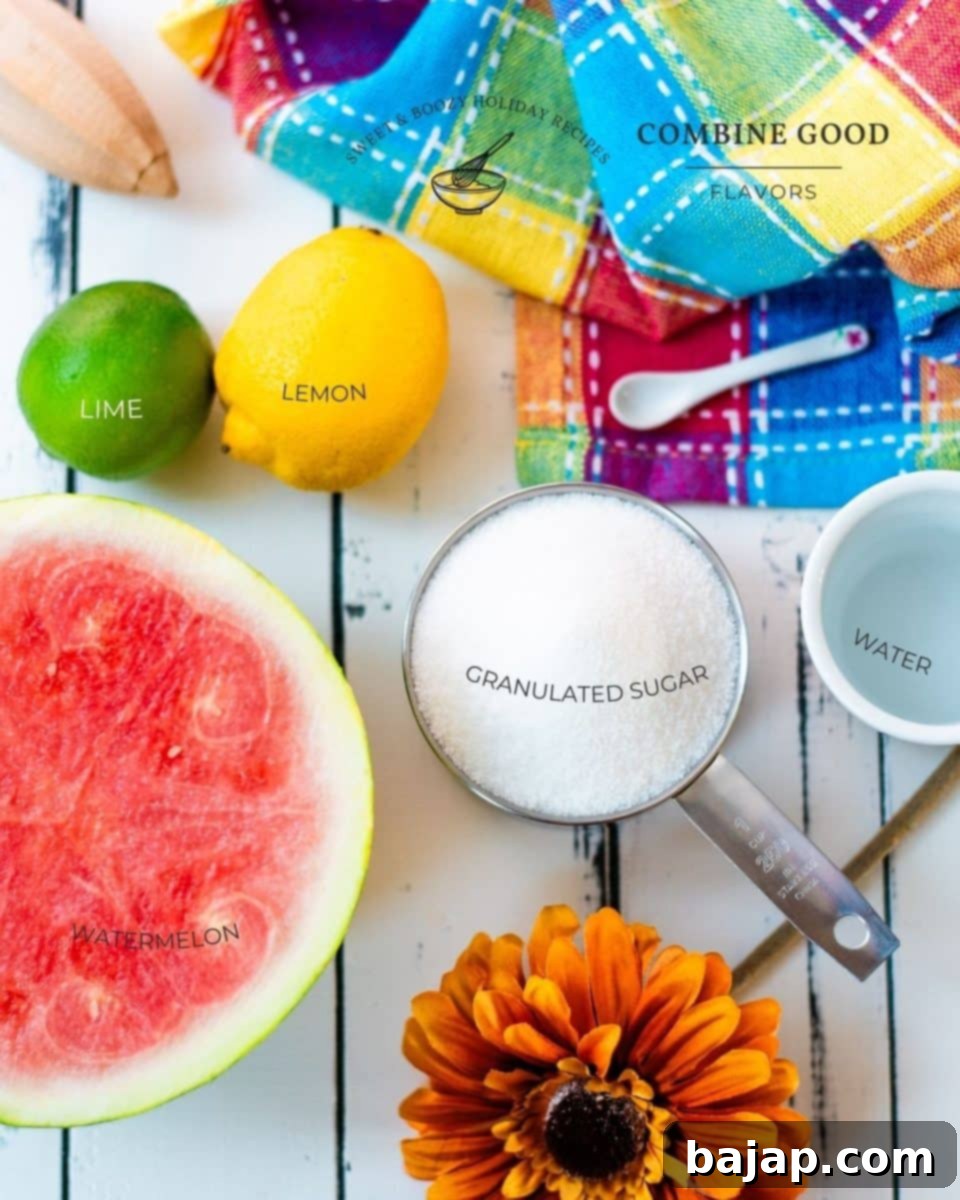
- ½ pound / 250 g Watermelon (fruit) – The star of our show! For the most intense and sweet syrup, always opt for a very ripe watermelon. If possible, choose a seedless variety to save on prep time, though seeded watermelons work just as well, just requiring a bit more effort in seed removal. A truly ripe watermelon will yield the most flavorful and naturally sweet juice for your syrup.
- ½ pound / 250 g White granulated sugar – This essential ingredient not only provides the necessary sweetness but also acts as a natural preservative, significantly extending the shelf life of your homemade syrup. The ratio of sugar to watermelon can be adjusted slightly to your personal preference, but this amount creates a perfectly balanced and palatable syrup.
- 4 ½ tablespoon / 65 ml Water – Used primarily in the boiling method to help dissolve the sugar thoroughly and achieve the ideal, pourable syrup consistency. In the no-boil method, it aids in the natural dissolution of sugar.
- 2 tablespoon / 30 ml Lime juice (freshly squeezed) – Adds a bright, zesty, and tangy citrus flavor that beautifully enhances the watermelon’s sweetness and prevents the syrup from tasting too flat or one-dimensional. Freshly squeezed is crucial for optimal, vibrant flavor.
- 2 tablespoon / 30 ml Lemon juice (freshly squeezed) – Similar to lime juice, lemon juice contributes to the syrup’s overall citrusy notes and helps balance the sweetness, creating a more complex and refreshing flavor profile. It also serves as a mild natural preservative, contributing to the syrup’s longevity.
🔪 Watermelon Syrup – Method with Boiling
This method involves a gentle simmer to ensure the sugar fully dissolves and the flavors meld beautifully, resulting in a slightly thicker and more shelf-stable syrup. Follow these detailed steps for a perfectly cooked watermelon syrup:
Step 1: Prepare the Watermelon. Begin by carefully removing any seeds from the watermelon. Then, cut the fruit into manageable pieces. Aim for chunks that are small enough to handle easily for pureeing. If you’re using a seeded watermelon, taking your time to remove as many seeds as possible at this stage will ensure a much smoother syrup later and save you extra straining effort.
Step 2: Puree the Watermelon. Transfer all the prepared watermelon pieces into a tall container. Using a hand blender (also known as an immersion blender), finely puree the melon until it’s completely smooth and liquid. Alternatively, a regular blender or food processor can be used. This step is essential for maximum flavor extraction and creating a uniform, lump-free base for your syrup.
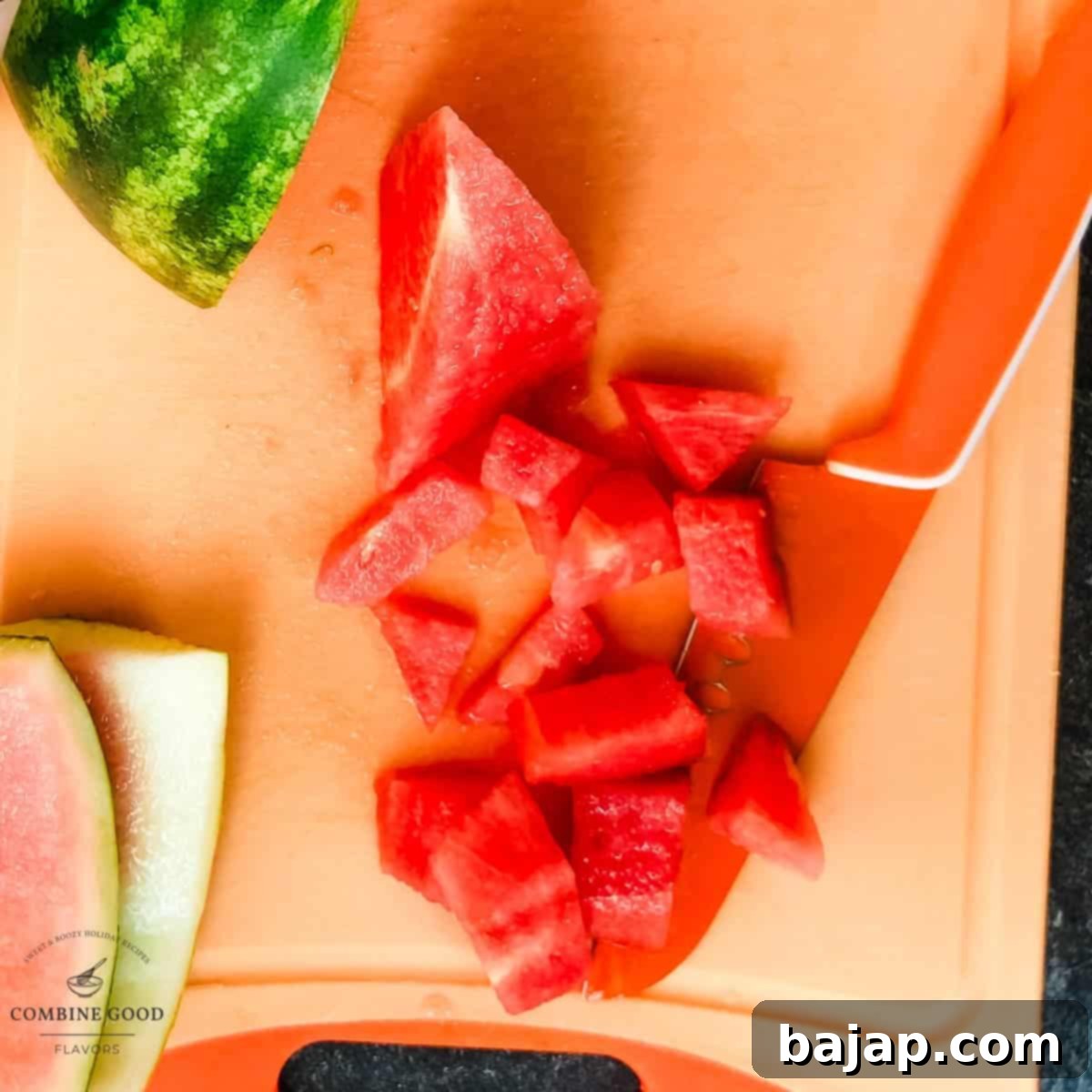
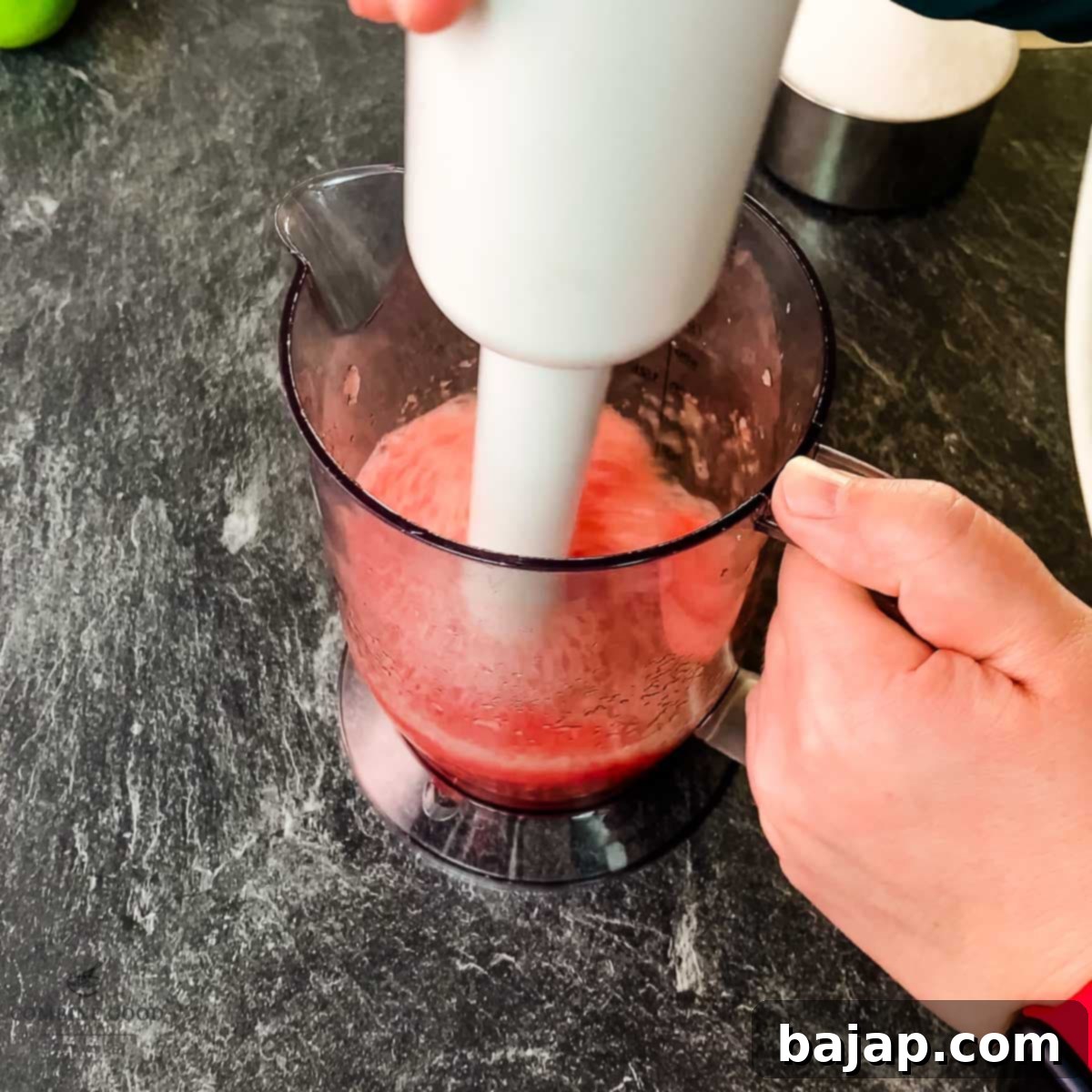
Step 3: Strain the Puree for Clarity. Place a fine-mesh sieve over a clean saucepan. Pour the puréed melon slowly through the sieve, using a spoon or spatula to gently press down on the solids and extract as much liquid as possible. This step is absolutely crucial for achieving a beautifully clear, smooth syrup without any pulp, fibrous bits, or remaining seeds. Discard the leftover pulp, or get creative and add it to smoothies or fruit leathers for extra flavor and fiber!
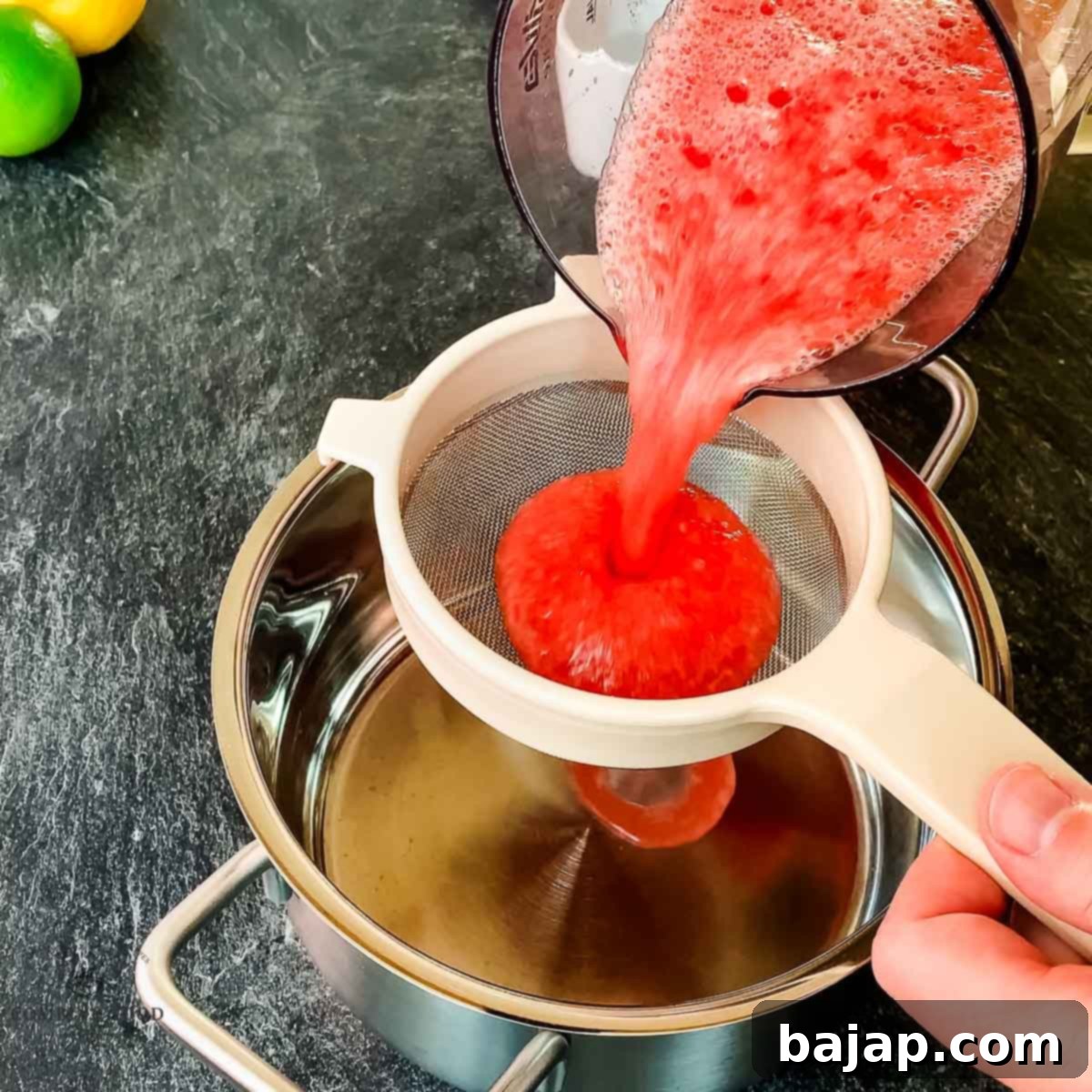
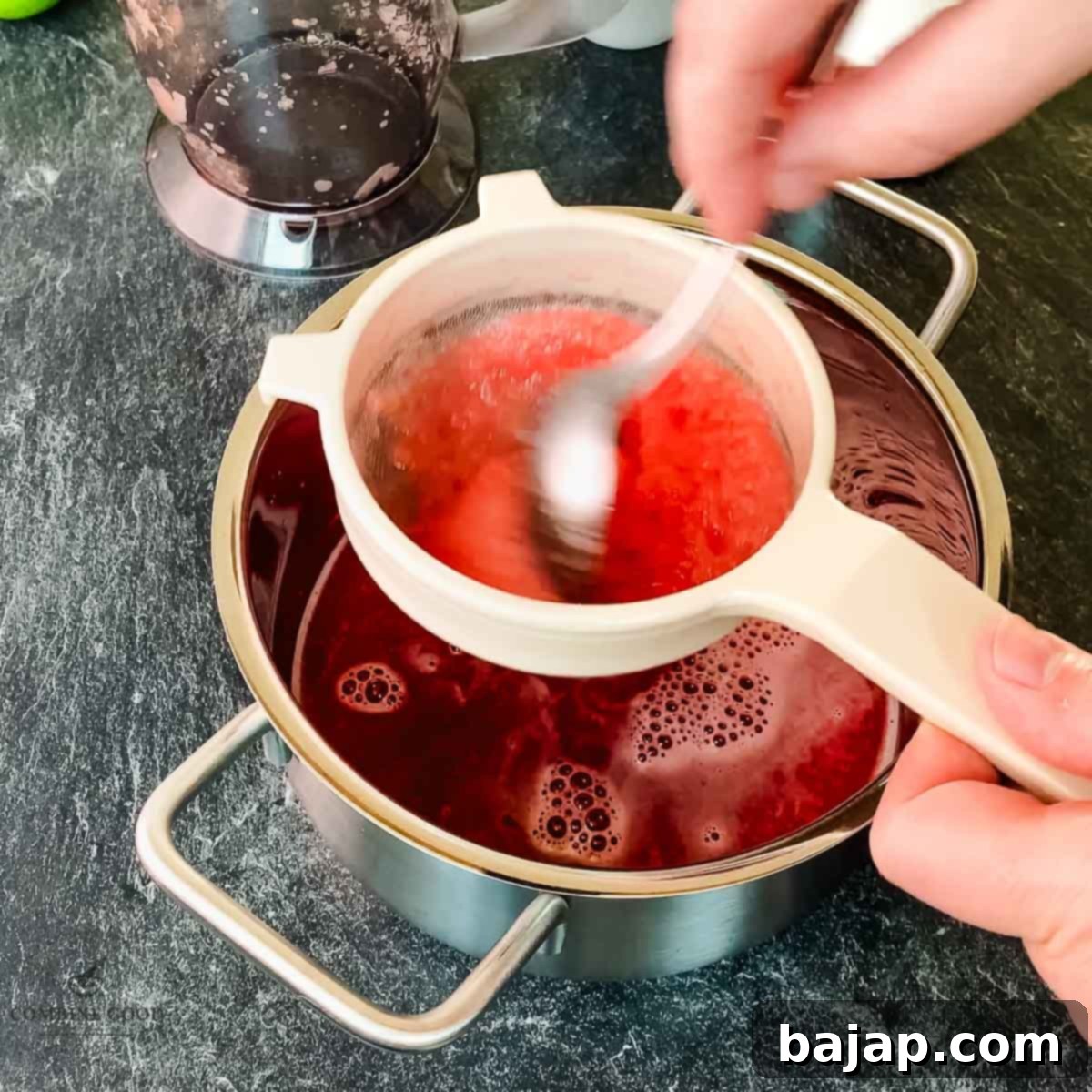
Step 4: Boil and Simmer to Perfection. To the saucepan containing the freshly strained watermelon juice, add the measured water, freshly squeezed lemon juice, lime juice, and granulated sugar. Stir everything together until the sugar begins to dissolve into the liquid. Bring the mixture to a rolling boil over medium-high heat, then immediately reduce the heat to a gentle simmer. Let it simmer for approximately 5 minutes, stirring occasionally. This brief boiling process helps dissolve the sugar completely, concentrates the watermelon flavor, and slightly thickens the syrup while also sterilizing it for better preservation.
Step 5: Bottle the Hot Syrup Safely. Carefully pour the hot watermelon syrup into thoroughly sterilized bottles or jars. Using a funnel can make this step much easier and safer, preventing messy spills and potential burns. Fill the bottles to just below the rim and seal them immediately with their lids. Sealing hot liquid in sterilized containers creates a vacuum as it cools, which is vital for proper preservation and extending the syrup’s shelf life.
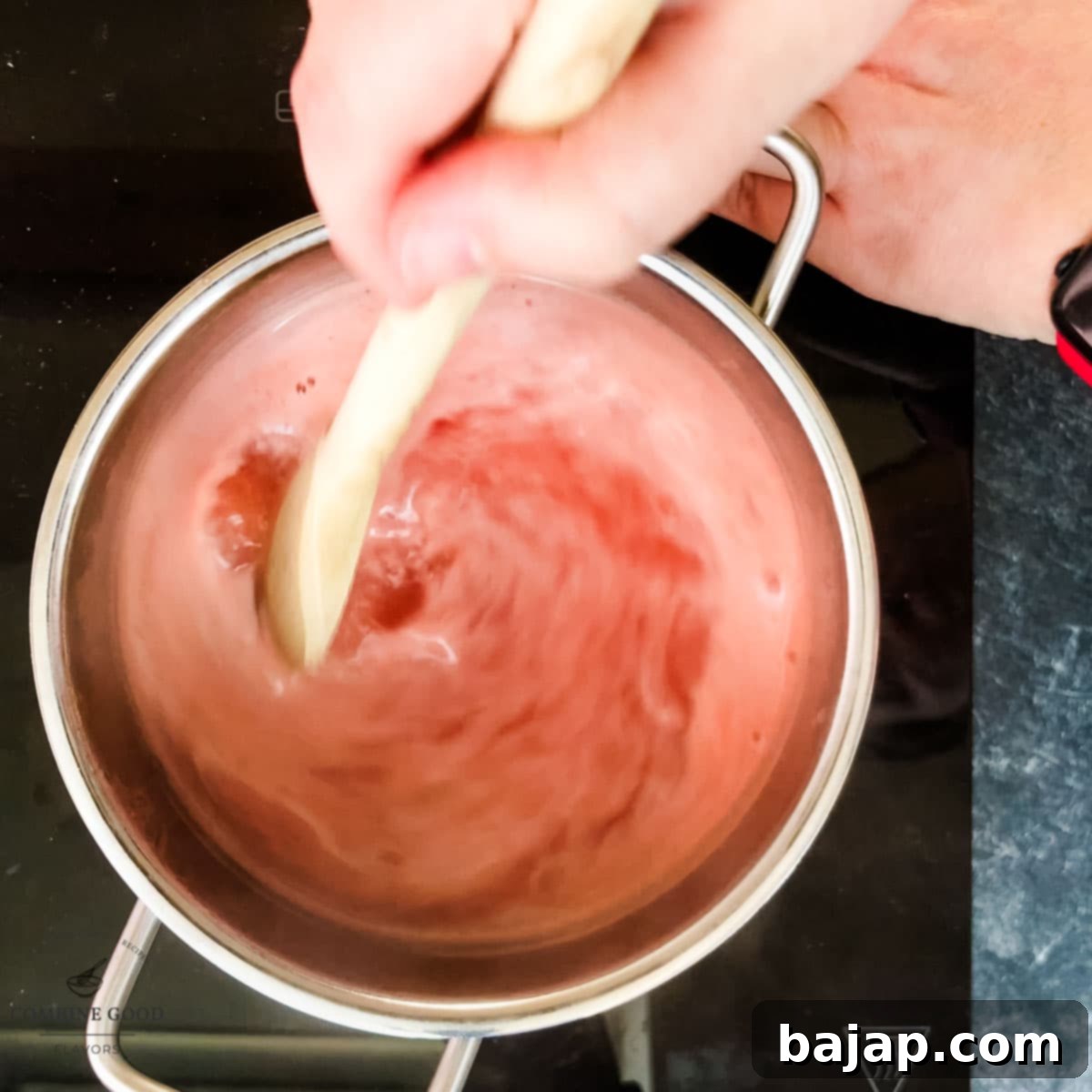
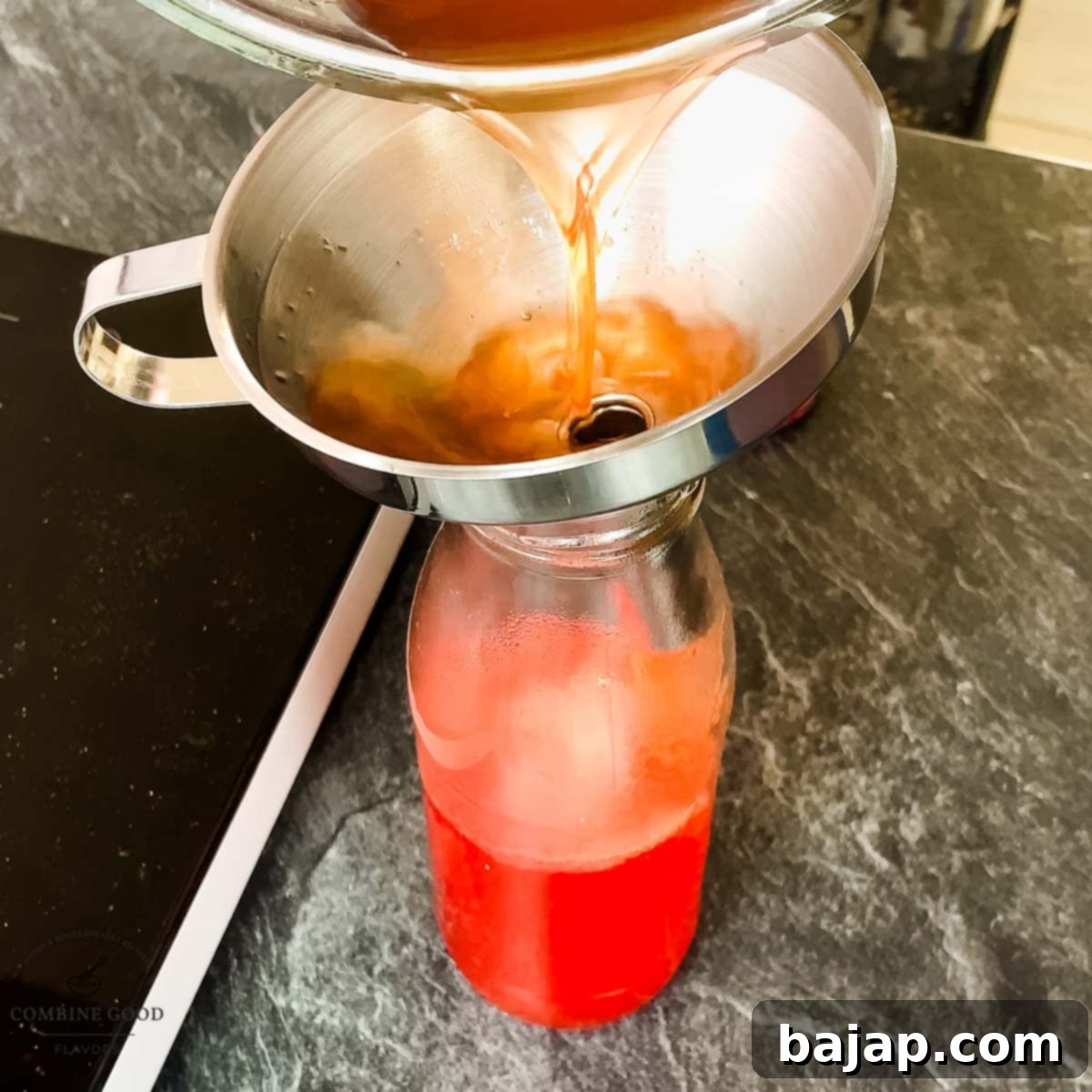
Step 6: Cool and Store Properly. Allow the sealed bottles of watermelon syrup to cool completely at room temperature on your countertop. This can take several hours. Once fully cooled, transfer them to the fridge for long-term storage. This method yields a beautifully clear, intensely flavored syrup that, when stored correctly, will last for several months, allowing you to enjoy summer’s taste well into the colder seasons.
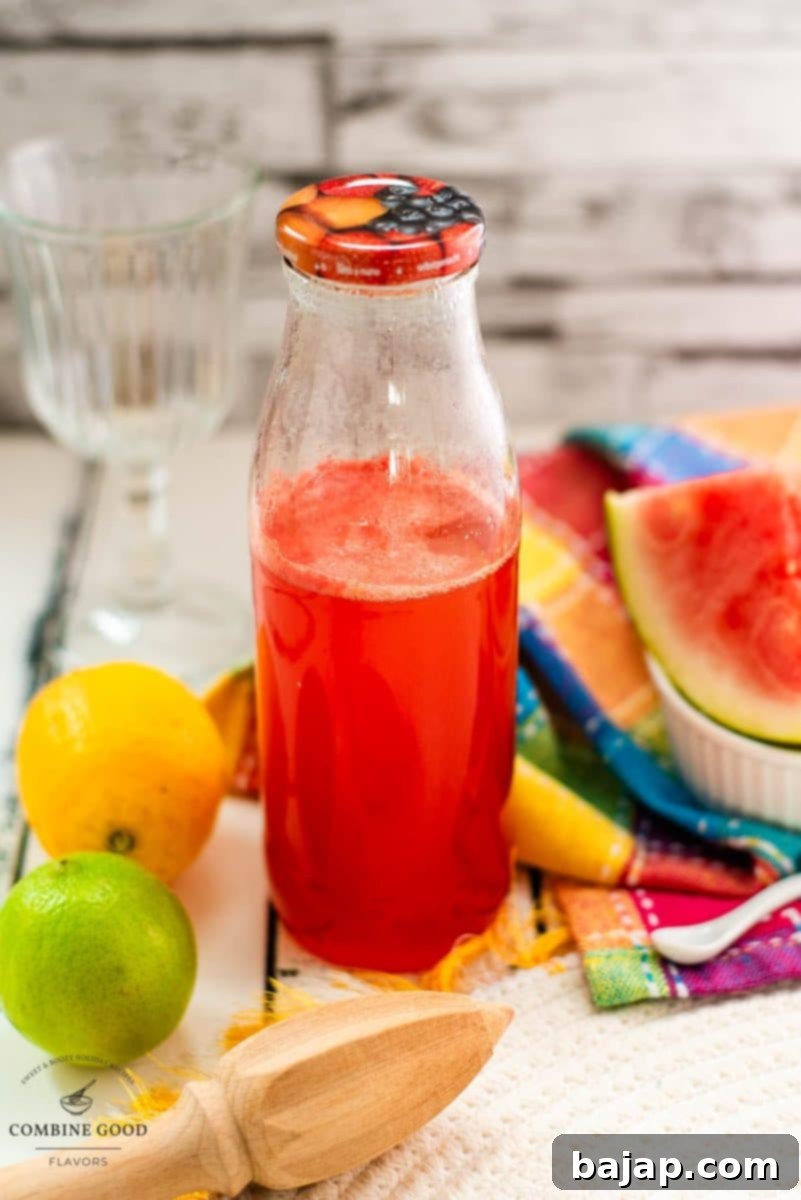
🔪 Watermelon Syrup – Alternate Method without Boiling (No-Cook Method)
For those who prefer a more “raw” flavor that highlights the fresh, delicate taste of watermelon even more, or if you’re looking for an even quicker preparation, this no-boil method is a fantastic alternative. It relies on time and natural dissolution for sweetness, preserving the fruit’s most authentic essence.
Step 1: Muddle and Combine. Begin by removing seeds and cutting your watermelon into pieces. Instead of pureeing, gently muddle these watermelon pieces directly in a clean preserving jar. Muddling helps effectively release the juices and flavors without altering them with heat. Then, combine the muddled watermelon with the remaining ingredients: water, freshly squeezed lemon juice, lime juice, and granulated sugar, directly in the preserving jar. Stir thoroughly to ensure all ingredients are well mixed and the sugar is somewhat distributed.
Step 2: Allow to Infuse and Dissolve Naturally. Seal the preserving jar tightly and place the mixture in the fridge. Let it sit undisturbed for a full 24 hours. During this crucial infusion period, the sugar will naturally dissolve into the watermelon juice and citrus, creating a beautifully infused syrup without any heat. This slow, cold infusion process allows the watermelon’s delicate and fresh flavors to truly shine through, resulting in a vibrant, uncooked syrup.
Step 3: Strain and Prepare for Use. After 24 hours of refrigeration, take the jar out. Carefully strain the entire contents through a fine-mesh sieve into a clean bottle or jar. Press down firmly on the watermelon solids with a spoon to extract every last drop of the flavorful syrup. This will leave you with a beautifully clear, vibrant, and incredibly fresh-tasting watermelon syrup.
Step 4: Enjoy Your Fresh Syrup! Your vibrant watermelon syrup, made without the need for boiling, is now ready to be enjoyed! This method yields a syrup with a noticeably fresher, more delicate, and intensely fruity watermelon flavor. Store it in the fridge and use it just as you would the boiled version. It’s a delicious and incredibly refreshing way to savor the essence of summer!
I highly recommend trying both methods to discover which one suits your taste and preference best! Each approach offers a slightly different nuance in flavor and texture, so experimenting is part of the fun.
🍋 Substitutions and Flavor Variations
While the basic recipe provides a perfectly balanced blend of watermelon and citrus, don’t hesitate to customize your homemade watermelon syrup to your liking with these exciting substitutions and variations:
- Citrus Choice: If you prefer a distinct flavor, you can opt to use either lime juice or lemon juice exclusively. Lemon tends to be a bit sharper and brighter, while lime offers a slightly more aromatic, subtly bitter, and floral tang. Experiment to find your personal favorite, or even try a blend of other citrus like orange or grapefruit for a unique twist.
- Herbal Infusion: For an extra layer of complexity and freshness, consider adding fresh herbs. A few sprigs of mint leaves or basil, or even a hint of rosemary, added during the simmering process (or with the no-boil method, letting them infuse with the watermelon) can create a sophisticated flavor profile. Remember to strain them out before bottling for a subtly herbaceous watermelon syrup.
- Spicy Kick: If you enjoy a touch of heat, a thin slice of jalapeño (seeds removed for less heat) or a tiny pinch of cayenne pepper can add an unexpected and delightful kick to your syrup, especially if you’re planning to use it in cocktails or savory glazes.
- Other Sweeteners: While white granulated sugar is recommended for clarity and its neutral taste, you could experiment with other sweeteners. Honey or maple syrup would impart their own distinct flavor notes and might alter the syrup’s color and consistency. Start with small amounts and adjust to taste.
- Floral Notes: A few drops of rose water or orange blossom water can add an exotic, floral aroma that pairs beautifully with watermelon. Add sparingly, as these flavors can be potent.
🌡️ Storage and Shelf Life of Watermelon Syrup
Proper storage is essential to extend the life of your homemade watermelon syrup and ensure it remains fresh, delicious, and safe to enjoy. Understanding the differences in shelf life between the two methods is also important.
- Refrigeration is Key: As this is a fresh fruit syrup with minimal preservatives (sugar and citrus), refrigeration is an absolute must. Store your sealed bottles or jars in the fridge immediately after they have cooled down.
- Shelf Life (Boiled Method): When properly sterilized and sealed, watermelon syrup made with the boiling method has a considerably longer shelf life. It can last for several months in the refrigerator, typically up to 2-3 months. Always check for any signs of spoilage (such as an unusual smell, visible mold, cloudiness, or fermentation) before use.
- Shelf Life (No-Boil Method): The no-boil method produces a syrup with a noticeably fresher, more delicate flavor, but it naturally has a slightly shorter shelf life due to the lack of heat treatment. Expect it to last for about 2-3 weeks in the refrigerator. Consume this version more quickly to enjoy its peak freshness.
- Freezing for Longer Preservation: For even longer preservation, you can freeze watermelon syrup! Pour the cooled syrup into ice cube trays and once completely frozen, transfer the watermelon syrup cubes to an airtight freezer bag or container. Frozen syrup cubes can last for up to 6 months and are perfectly convenient for dropping directly into drinks or using in recipes as needed.
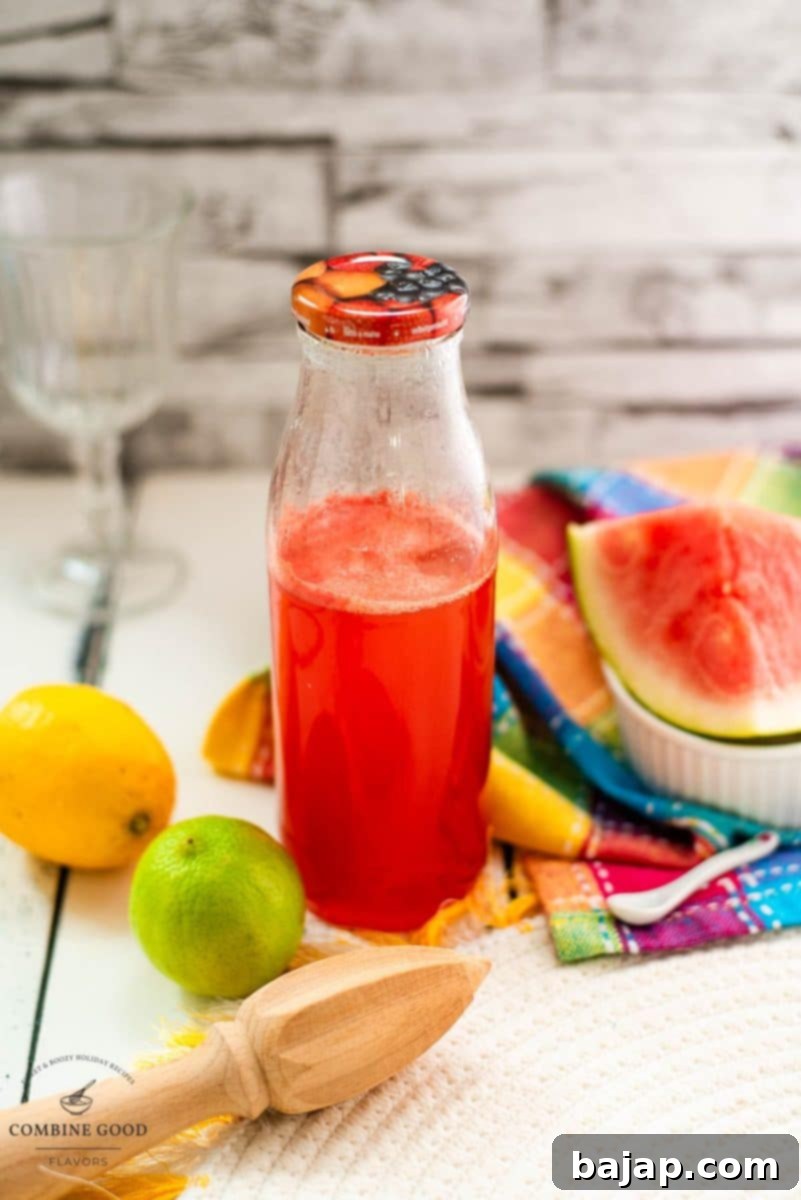
🍽 Essential Equipment for Making Watermelon Syrup
Making homemade watermelon syrup is relatively simple and doesn’t require a lot of specialized kitchen tools. Here’s a list of the essential equipment you’ll need, along with a brief explanation of why each piece is useful:
- Tall container: An ideal vessel for pureeing the watermelon without making a mess due to splashing, keeping your kitchen clean.
- Immersion blender: Perfect for quickly and smoothly pureeing the watermelon directly in a tall container or saucepan. If you don’t have one, a regular countertop blender or food processor will work just as well.
- Saucepan – Small: For simmering the syrup in the boiling method. Choose one with a heavy bottom to ensure even heat distribution and prevent the sugar from scorching.
- Spoon & Wooden Spoon: A regular spoon is useful for pressing pulp through the sieve, and a wooden spoon is great for stirring the syrup during simmering, preventing it from sticking to the bottom of the pan.
- Close-Meshed Sieve: This is a crucial tool for filtering out any pulp, seeds, or fibrous bits from the watermelon puree, ensuring you achieve a clear and smooth syrup. For an extra-fine strain, you can line it with cheesecloth.
- Funnel: An invaluable aid for safely and cleanly pouring the hot syrup into narrow-necked bottles or jars, minimizing spills and waste.
- Muddler – Essential for the alternate no-boil method, allowing you to effectively extract juices and flavors from the watermelon pieces without applying heat.
- Airtight Glass Containers (Sterilized) – Such as mason jars or swing-top bottles, which are perfect for storing your homemade syrup. Properly sterilizing them before use is absolutely vital for food safety and extending the shelf life of your syrup.
💭 Top Tips for the Best Watermelon Syrup
- Choose the Right Watermelon: This is paramount for achieving the best flavor. Only use ripe watermelons for the most intense, naturally sweet, and vibrant taste. Here’s how to pick a winner:
- The “Thump Test”: Gently tap the watermelon with your knuckles. A perfectly ripe watermelon will produce a deep, hollow sound, indicating it’s full of water and ripe. If it sounds dull, mushy, or flat, it may be under-ripe or over-ripe.
- Weight Test: A ripe watermelon should feel surprisingly heavy for its size. This is a good sign that it’s packed with juice and moisture, which translates to sweetness.
- Field Spot (Yellow Spot): Look for a creamy yellow or orange-yellow spot on the underside of the watermelon. This “field spot” is where the watermelon rested on the ground and ripened in the sun. A white or greenish spot suggests it was picked too early and didn’t have enough time to ripen fully.
- Dull Appearance: A ripe watermelon will typically have a dull, rather than shiny, rind. A glossy rind often indicates it’s under-ripe.
- Seedless for Speed: While not essential, trying to get your hands on a seedless watermelon can significantly speed up your preparation time and simplify the pureeing process.
- Adjust Sweetness to Taste: Taste the watermelon puree before adding the full amount of sugar. If your watermelon is exceptionally sweet, you might reduce the sugar slightly. If it’s less sweet, you might consider adding a touch more. This allows you to tailor the syrup to your preference.
- Cleanliness is Key for Preservation: Always work with clean hands and thoroughly sterilized equipment, especially when preserving syrups. This practice is crucial to prevent bacterial growth and ensure your homemade syrup lasts longer and is safe to consume.
How to Sterilize Glass Containers?
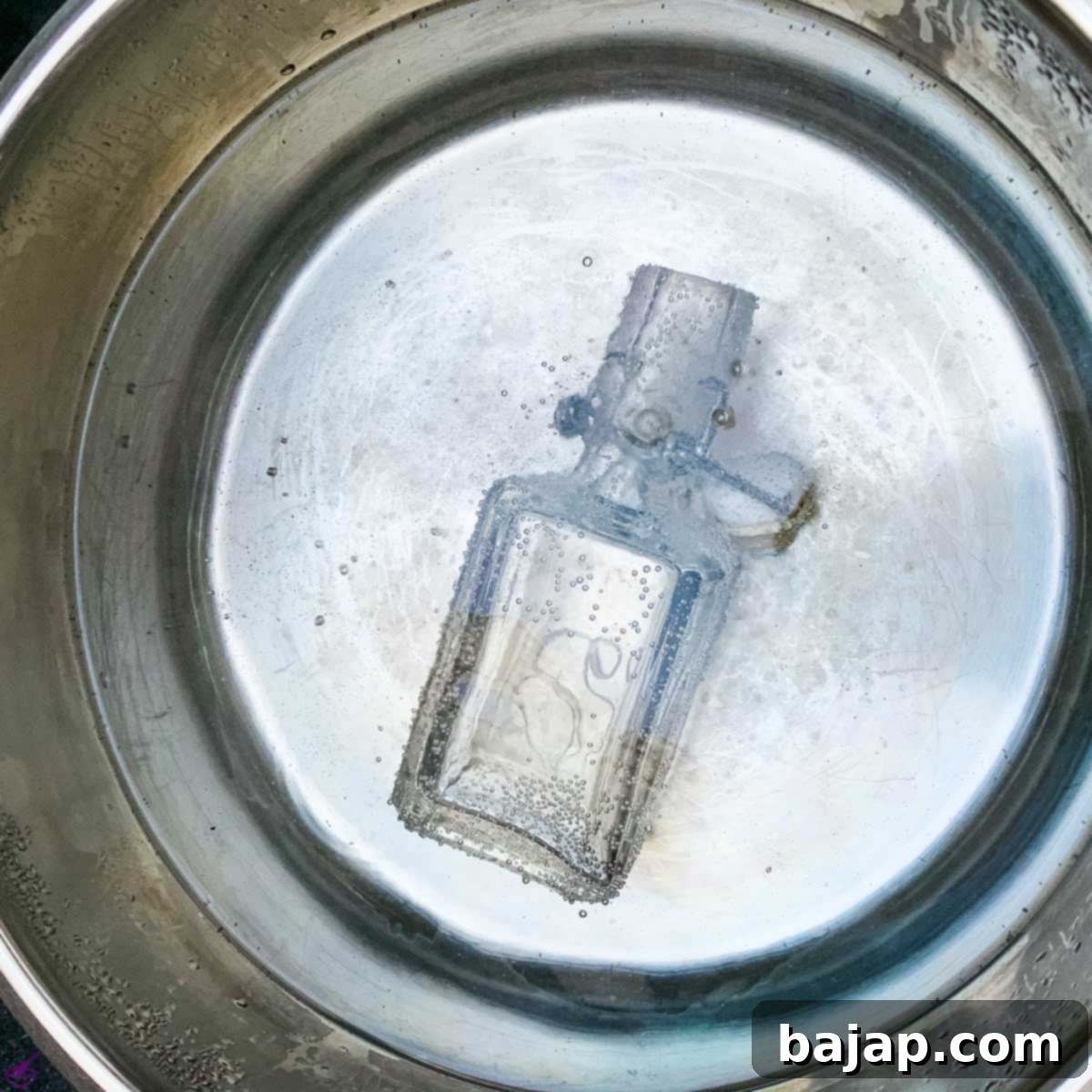
Proper sterilization is critical for any preserved food product, including your homemade watermelon syrup. It helps eliminate bacteria and extends the shelf life of your syrup significantly. Here’s a simple and effective method:
To sterilize glass containers (jars and bottles), prepare a hot water bath. Place the clean jars, bottles, and their lids into a large pot, ensuring they are fully submerged in water. Bring the water to a rolling boil and maintain the boil for at least 10-15 minutes. This sufficient for sterilizing empty jars for short-to-medium term storage. Carefully remove each item using clean tongs, letting any excess water drain back into the pot. Place them upside down on clean paper towels or a clean kitchen towel to air dry completely. Avoid touching the inside of the jars or lids once sterilized. Use them while they are still warm for the best results, especially with the boiling method for the syrup, as the temperature difference helps create a strong seal.
🍉 Serving Suggestions: How to Enjoy Your Watermelon Syrup
Once you’ve crafted your beautiful homemade watermelon syrup, the fun truly begins! Its vibrant flavor and stunning ruby-red color make it an incredibly versatile addition to countless dishes and drinks. Get ready to impress with these fantastic ways to enjoy your delicious creation:
- Refreshing Beverages:
- Sparkling Water or Soda: A simple splash of watermelon syrup in sparkling water or club soda, garnished with a slice of lime and a sprig of fresh mint, makes for an instant, elegant, and perfectly non-alcoholic refresher. It’s hydration with a delicious twist!
- Lemonades & Iced Teas: Elevate your classic homemade lemonade or iced tea by stirring in some watermelon syrup. It adds a fruity sweetness and beautiful hue that’s absolutely perfect for warm weather.
- Cocktails: This syrup is a game-changer for home mixologists! Use it to sweeten and flavor margaritas, mojitos, gin fizzes, or even a simple vodka soda for a wonderfully summery and unique twist. It pairs exceptionally well with white spirits.
- Mocktails: Create sophisticated alcohol-free drinks by combining it with other fruit juices (like pineapple or orange), a touch of herbs, and sparkling water or ginger ale.
- Decadent Desserts:
- Ice Cream & Yogurt: Drizzle generously over vanilla ice cream, frozen yogurt, or a fruit parfait for an explosion of summery flavor and a delightful pop of color.
- Pancakes & Waffles: Move beyond traditional maple syrup! Watermelon syrup makes a delightful, unexpected, and light topping for your breakfast favorites, especially when served with fresh berries.
- Fruit Salads: Toss a fresh fruit salad (especially with other melons, berries, or stone fruits) with a light coating of watermelon syrup to enhance the natural sweetness and add a cohesive fruity glaze.
- Cakes & Cupcakes: Use it to moisten cake layers, flavor buttercream frosting, or create a gorgeous, glossy glaze for a truly summery dessert. It can also be brushed onto warm pastries.
- Creative Culinary Uses:
- Smoothies: Add a tablespoon or two of watermelon syrup to your morning smoothie for an extra burst of refreshing flavor and a natural sweetener.
- Salad Dressings: Whisk a small amount into vinaigrettes for a sweet and tangy dressing that’s perfect for salads featuring goat cheese, grilled chicken, or peppery greens.
- Marinades & Glazes: Surprisingly, watermelon syrup can make a fantastic glaze for grilled chicken or pork, offering a unique sweet, fruity, and slightly tangy caramelization.
❓ Troubleshooting & Frequently Asked Questions (FAQs)
Don’t worry if you encounter any issues or have questions; making syrup is quite forgiving! Here are some common questions and their solutions to help you on your syrup-making journey:
- Why is my syrup not thickening? The boiling method concentrates the sugars, which naturally leads to a thicker syrup. If yours seems too thin, simply return it to the saucepan and simmer for a few more minutes until it reaches your desired consistency. Remember, the syrup will thicken slightly more as it cools. The no-boil method will naturally yield a thinner, more juice-like syrup, which is its intended consistency.
- Can I use frozen watermelon? Yes, you absolutely can! If fresh watermelon isn’t in season or readily available, thawed frozen watermelon can be used. Just be aware that it might release more water during the thawing process, so you might need to simmer the boiled version a little longer to achieve the desired thickness and flavor concentration.
- Can I reduce the sugar content? Yes, you can reduce the sugar content to suit your taste. However, it’s important to remember that sugar plays a crucial role in preservation. If you significantly reduce the sugar, the shelf life of your syrup will be shorter (especially for the no-boil version), and it might need to be consumed more quickly or stored by freezing. Taste and adjust incrementally.
- My syrup looks cloudy, is it okay? A cloudy syrup usually means you haven’t strained the puree finely enough, and some small fruit particles remain. It’s still perfectly safe to consume and will taste delicious, just not as aesthetically clear as a fully strained syrup. For a crystal-clear syrup, ensure you use a very fine-mesh sieve or even line your sieve with several layers of cheesecloth for straining.
- What if I don’t have an immersion blender? No problem at all! A regular upright blender or a food processor will work perfectly for pureeing the watermelon. Just transfer the cut pieces to your blender, process until completely smooth, and then proceed with the straining step.
- Can I make a larger batch? Absolutely! This recipe scales up very easily. Just ensure you have a large enough saucepan and enough sterilized bottles or jars for storage. The cook times for the boiling method might need to be slightly extended if you’re making a significantly larger quantity to ensure proper thickness and sugar dissolution.
Other Refreshing Recipes for You to Try
- Mini Blueberry Pavlova
- Coconut Pound Cake
- No-bake Lemon Cheesecake
- Vanilla Ice Cream
–> more Summer Recipes
If you make this homemade watermelon syrup recipe, please let me know how you liked it by ★★★★★ star rating it and leaving a comment below. Your feedback is invaluable and helps other home cooks discover this delicious recipe! This would be awesome! You can also sign up for our Newsletter or follow me on Pinterest or Instagram and share your creation with me. Just tag me @combinegoodflavors and hashtag #combinegoodflavors, so I don’t miss it. Happy cooking!
📖 Recipe: Homemade Watermelon Syrup
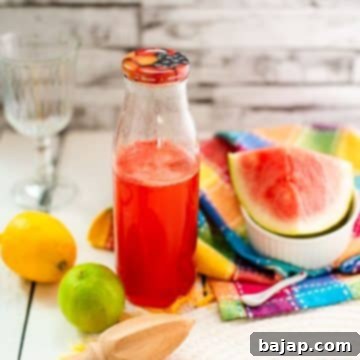
Watermelon Syrup Recipe
Nora
Save RecipeSaved!
Pin Recipe
Equipment
-
Tall container
-
Immersion blender
-
Saucepan small
-
Wooden spoon
-
Spoon
-
Close meshed sieve
-
Funnel
-
Muddler for the alternate version without boiling
